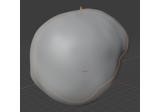mne.write_head_bem#
- mne.write_head_bem(fname, rr, tris, on_defects='raise', overwrite=False, verbose=None)[source]#
Write a head surface to a fiff file.
- Parameters
- fname
str Filename to write.
- rr
array, shape (n_vertices, 3) Coordinate points in the MRI coordinate system.
- tris
ndarrayofint, shape (n_tris, 3) Triangulation (each line contains indices for three points which together form a face).
- on_defects‘raise’ | ‘warn’ | ‘ignore’
What to do if the surface is found to have topological defects. Can be
'raise'(default) to raise an error,'warn'to emit a warning, or'ignore'to ignore when one or more defects are found. Note that a lot of computations in MNE-Python assume the surfaces to be topologically correct, topological defects may still make other computations (e.g.,mne.make_bem_modelandmne.make_bem_solution) fail irrespective of this parameter.- overwritebool
If True (default False), overwrite the destination file if it exists.
- verbosebool |
str|int|None Control verbosity of the logging output. If
None, use the default verbosity level. See the logging documentation andmne.verbose()for details. Should only be passed as a keyword argument.
- fname
